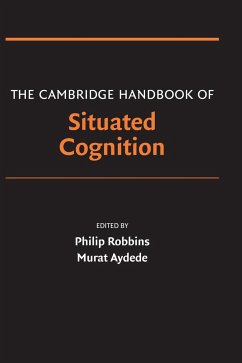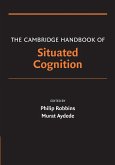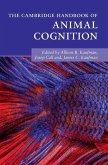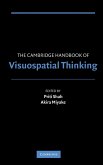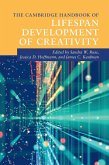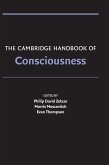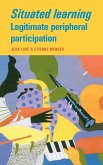The Cambridge Handbook of Situated Cognition
Herausgeber: Robbins, Philip; Aydede, Murat
The Cambridge Handbook of Situated Cognition
Herausgeber: Robbins, Philip; Aydede, Murat
- Gebundenes Buch
- Merkliste
- Auf die Merkliste
- Bewerten Bewerten
- Teilen
- Produkt teilen
- Produkterinnerung
- Produkterinnerung
State-of-the-art guide to a new movement in cognitive science showing how environmental and bodily structure shapes cognition.
Andere Kunden interessierten sich auch für
![The Cambridge Handbook of Situated Cognition The Cambridge Handbook of Situated Cognition]() The Cambridge Handbook of Situated Cognition71,99 €
The Cambridge Handbook of Situated Cognition71,99 €![The Cambridge Handbook of Animal Cognition The Cambridge Handbook of Animal Cognition]() The Cambridge Handbook of Animal Cognition183,99 €
The Cambridge Handbook of Animal Cognition183,99 €![The Cambridge Handbook of Expertise and Expert Performance The Cambridge Handbook of Expertise and Expert Performance]() The Cambridge Handbook of Expertise and Expert Performance172,99 €
The Cambridge Handbook of Expertise and Expert Performance172,99 €![The Cambridge Handbook of Visuospatial Thinking The Cambridge Handbook of Visuospatial Thinking]() Priti Shah / Akira Miyake (eds.)The Cambridge Handbook of Visuospatial Thinking111,99 €
Priti Shah / Akira Miyake (eds.)The Cambridge Handbook of Visuospatial Thinking111,99 €![The Cambridge Handbook of Lifespan Development of Creativity The Cambridge Handbook of Lifespan Development of Creativity]() The Cambridge Handbook of Lifespan Development of Creativity177,99 €
The Cambridge Handbook of Lifespan Development of Creativity177,99 €![The Cambridge Handbook of Consciousness The Cambridge Handbook of Consciousness]() Philip David Zelazo / Morris Moscovitch / Evan Thompson (eds.)The Cambridge Handbook of Consciousness211,99 €
Philip David Zelazo / Morris Moscovitch / Evan Thompson (eds.)The Cambridge Handbook of Consciousness211,99 €![Situated Learning Situated Learning]() Jean LaveSituated Learning68,99 €
Jean LaveSituated Learning68,99 €-
-
-
State-of-the-art guide to a new movement in cognitive science showing how environmental and bodily structure shapes cognition.
Hinweis: Dieser Artikel kann nur an eine deutsche Lieferadresse ausgeliefert werden.
Hinweis: Dieser Artikel kann nur an eine deutsche Lieferadresse ausgeliefert werden.
Produktdetails
- Produktdetails
- Verlag: Cambridge University Press
- Seitenzahl: 534
- Erscheinungstermin: 7. April 2015
- Englisch
- Abmessung: 260mm x 183mm x 33mm
- Gewicht: 1188g
- ISBN-13: 9780521848329
- ISBN-10: 0521848326
- Artikelnr.: 24927884
- Herstellerkennzeichnung
- Libri GmbH
- Europaallee 1
- 36244 Bad Hersfeld
- gpsr@libri.de
- Verlag: Cambridge University Press
- Seitenzahl: 534
- Erscheinungstermin: 7. April 2015
- Englisch
- Abmessung: 260mm x 183mm x 33mm
- Gewicht: 1188g
- ISBN-13: 9780521848329
- ISBN-10: 0521848326
- Artikelnr.: 24927884
- Herstellerkennzeichnung
- Libri GmbH
- Europaallee 1
- 36244 Bad Hersfeld
- gpsr@libri.de
Part I. Backdrop: 1. A short primer on situated cognition Philip Robbins
and Murat Aydede; 2. Scientific antecedents of situated cognition William
J. Clancey; 3. Philosophical antecedents of situated cognition Shaun
Gallagher; Part II. Conceptual Foundations: 4. How to situate cognition:
letting nature take its course Robert A. Wilson and Andy Clark; 5. Why the
mind is still in the head Fred Adams and Kenneth Aizawa; 6. Innateness and
the situated mind Robert Rupert; 7. Situated representation Mark Rowlands;
8. Dynamics, control, and cognition Chris Eliasmith; 9. Explanation:
mechanism, modularity, and situated cognition William Bechtel; 10. Embedded
rationality Ruth Millikan; Part III. Empirical Developments: 11. Situated
perception and sensation in vision and other modalities: from an active to
a sensorimotor account Erik Myin and Kevin O'Regan; 12. Spaces of thought
Barbara Tversky; 13. Remembering John Sutton; 14. Situating concepts
Lawrence W. Barsalou; 15. Problem-solving and situated cognition David
Kirsh; 16. The dynamic interactions between situations and decisions Jerome
R. Busemeyer, Ryan K. Jessup and Eric Dimperio; 17. Situating rationality:
ecologically rational decision making with simple heuristics Henry Brighton
and Peter M. Todd; 18. Situativity and learning R. Keith Sawyer and James
G. Greeno; 19. Language in the brain, body, and world Rolf A. Zwaan and
Michael P. Kaschak; 20. Language processing embodied and embedded Michael
Spivey and Daniel Richardson; 21. Situated semantics Varol Akman; 22. Is
consciousness embodied? Jesse J. Prinz; 23. Emotions in the wild: the
situated perspective on emotion Paul Griffiths and Andrea Scarantino; 24.
The social context of cognition Eliot R. Smith and Frederica R. Conrey; 25.
Cognition for culture Michael Tomasello and Felix Warneken; 26.
Neuroethology: from morphological computation to planning Malcolm A.
MacIver.
and Murat Aydede; 2. Scientific antecedents of situated cognition William
J. Clancey; 3. Philosophical antecedents of situated cognition Shaun
Gallagher; Part II. Conceptual Foundations: 4. How to situate cognition:
letting nature take its course Robert A. Wilson and Andy Clark; 5. Why the
mind is still in the head Fred Adams and Kenneth Aizawa; 6. Innateness and
the situated mind Robert Rupert; 7. Situated representation Mark Rowlands;
8. Dynamics, control, and cognition Chris Eliasmith; 9. Explanation:
mechanism, modularity, and situated cognition William Bechtel; 10. Embedded
rationality Ruth Millikan; Part III. Empirical Developments: 11. Situated
perception and sensation in vision and other modalities: from an active to
a sensorimotor account Erik Myin and Kevin O'Regan; 12. Spaces of thought
Barbara Tversky; 13. Remembering John Sutton; 14. Situating concepts
Lawrence W. Barsalou; 15. Problem-solving and situated cognition David
Kirsh; 16. The dynamic interactions between situations and decisions Jerome
R. Busemeyer, Ryan K. Jessup and Eric Dimperio; 17. Situating rationality:
ecologically rational decision making with simple heuristics Henry Brighton
and Peter M. Todd; 18. Situativity and learning R. Keith Sawyer and James
G. Greeno; 19. Language in the brain, body, and world Rolf A. Zwaan and
Michael P. Kaschak; 20. Language processing embodied and embedded Michael
Spivey and Daniel Richardson; 21. Situated semantics Varol Akman; 22. Is
consciousness embodied? Jesse J. Prinz; 23. Emotions in the wild: the
situated perspective on emotion Paul Griffiths and Andrea Scarantino; 24.
The social context of cognition Eliot R. Smith and Frederica R. Conrey; 25.
Cognition for culture Michael Tomasello and Felix Warneken; 26.
Neuroethology: from morphological computation to planning Malcolm A.
MacIver.
Part I. Backdrop: 1. A short primer on situated cognition Philip Robbins
and Murat Aydede; 2. Scientific antecedents of situated cognition William
J. Clancey; 3. Philosophical antecedents of situated cognition Shaun
Gallagher; Part II. Conceptual Foundations: 4. How to situate cognition:
letting nature take its course Robert A. Wilson and Andy Clark; 5. Why the
mind is still in the head Fred Adams and Kenneth Aizawa; 6. Innateness and
the situated mind Robert Rupert; 7. Situated representation Mark Rowlands;
8. Dynamics, control, and cognition Chris Eliasmith; 9. Explanation:
mechanism, modularity, and situated cognition William Bechtel; 10. Embedded
rationality Ruth Millikan; Part III. Empirical Developments: 11. Situated
perception and sensation in vision and other modalities: from an active to
a sensorimotor account Erik Myin and Kevin O'Regan; 12. Spaces of thought
Barbara Tversky; 13. Remembering John Sutton; 14. Situating concepts
Lawrence W. Barsalou; 15. Problem-solving and situated cognition David
Kirsh; 16. The dynamic interactions between situations and decisions Jerome
R. Busemeyer, Ryan K. Jessup and Eric Dimperio; 17. Situating rationality:
ecologically rational decision making with simple heuristics Henry Brighton
and Peter M. Todd; 18. Situativity and learning R. Keith Sawyer and James
G. Greeno; 19. Language in the brain, body, and world Rolf A. Zwaan and
Michael P. Kaschak; 20. Language processing embodied and embedded Michael
Spivey and Daniel Richardson; 21. Situated semantics Varol Akman; 22. Is
consciousness embodied? Jesse J. Prinz; 23. Emotions in the wild: the
situated perspective on emotion Paul Griffiths and Andrea Scarantino; 24.
The social context of cognition Eliot R. Smith and Frederica R. Conrey; 25.
Cognition for culture Michael Tomasello and Felix Warneken; 26.
Neuroethology: from morphological computation to planning Malcolm A.
MacIver.
and Murat Aydede; 2. Scientific antecedents of situated cognition William
J. Clancey; 3. Philosophical antecedents of situated cognition Shaun
Gallagher; Part II. Conceptual Foundations: 4. How to situate cognition:
letting nature take its course Robert A. Wilson and Andy Clark; 5. Why the
mind is still in the head Fred Adams and Kenneth Aizawa; 6. Innateness and
the situated mind Robert Rupert; 7. Situated representation Mark Rowlands;
8. Dynamics, control, and cognition Chris Eliasmith; 9. Explanation:
mechanism, modularity, and situated cognition William Bechtel; 10. Embedded
rationality Ruth Millikan; Part III. Empirical Developments: 11. Situated
perception and sensation in vision and other modalities: from an active to
a sensorimotor account Erik Myin and Kevin O'Regan; 12. Spaces of thought
Barbara Tversky; 13. Remembering John Sutton; 14. Situating concepts
Lawrence W. Barsalou; 15. Problem-solving and situated cognition David
Kirsh; 16. The dynamic interactions between situations and decisions Jerome
R. Busemeyer, Ryan K. Jessup and Eric Dimperio; 17. Situating rationality:
ecologically rational decision making with simple heuristics Henry Brighton
and Peter M. Todd; 18. Situativity and learning R. Keith Sawyer and James
G. Greeno; 19. Language in the brain, body, and world Rolf A. Zwaan and
Michael P. Kaschak; 20. Language processing embodied and embedded Michael
Spivey and Daniel Richardson; 21. Situated semantics Varol Akman; 22. Is
consciousness embodied? Jesse J. Prinz; 23. Emotions in the wild: the
situated perspective on emotion Paul Griffiths and Andrea Scarantino; 24.
The social context of cognition Eliot R. Smith and Frederica R. Conrey; 25.
Cognition for culture Michael Tomasello and Felix Warneken; 26.
Neuroethology: from morphological computation to planning Malcolm A.
MacIver.

